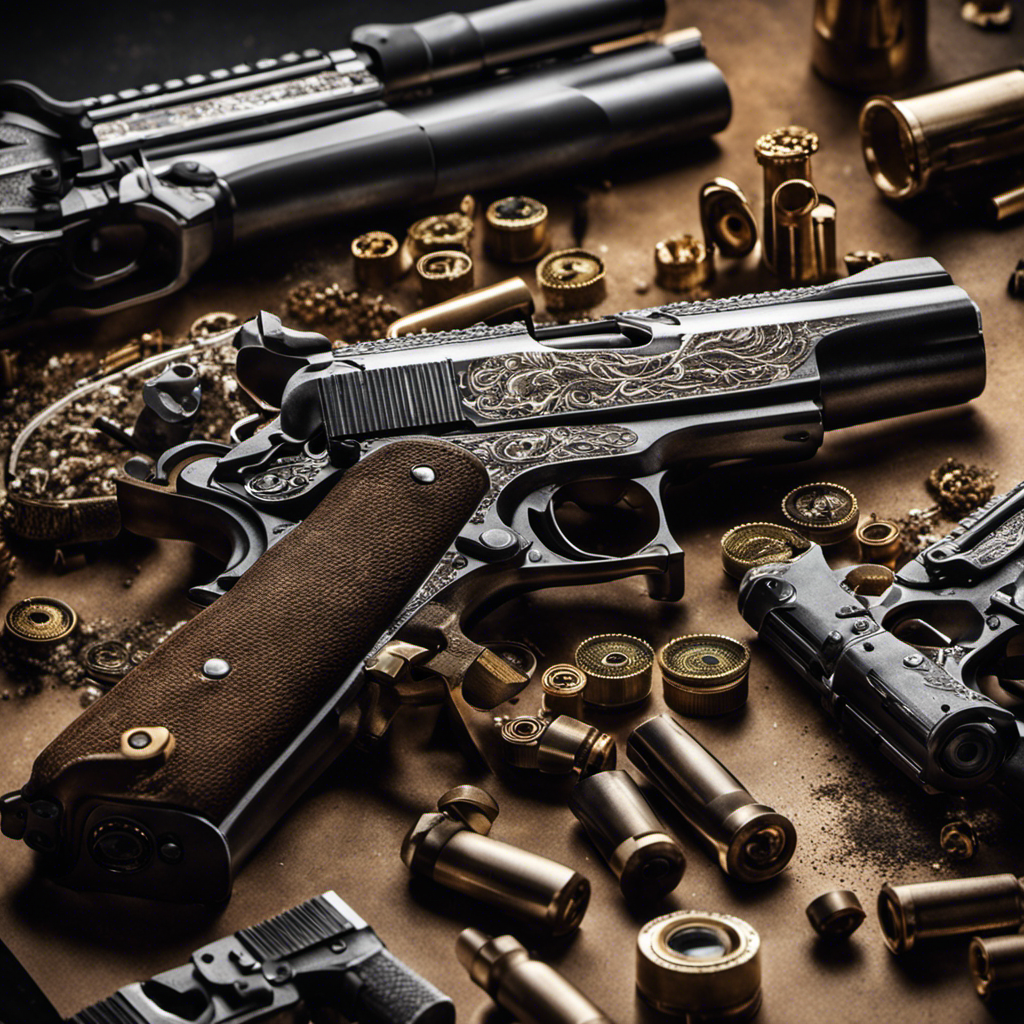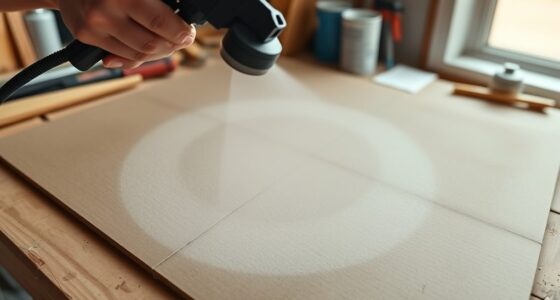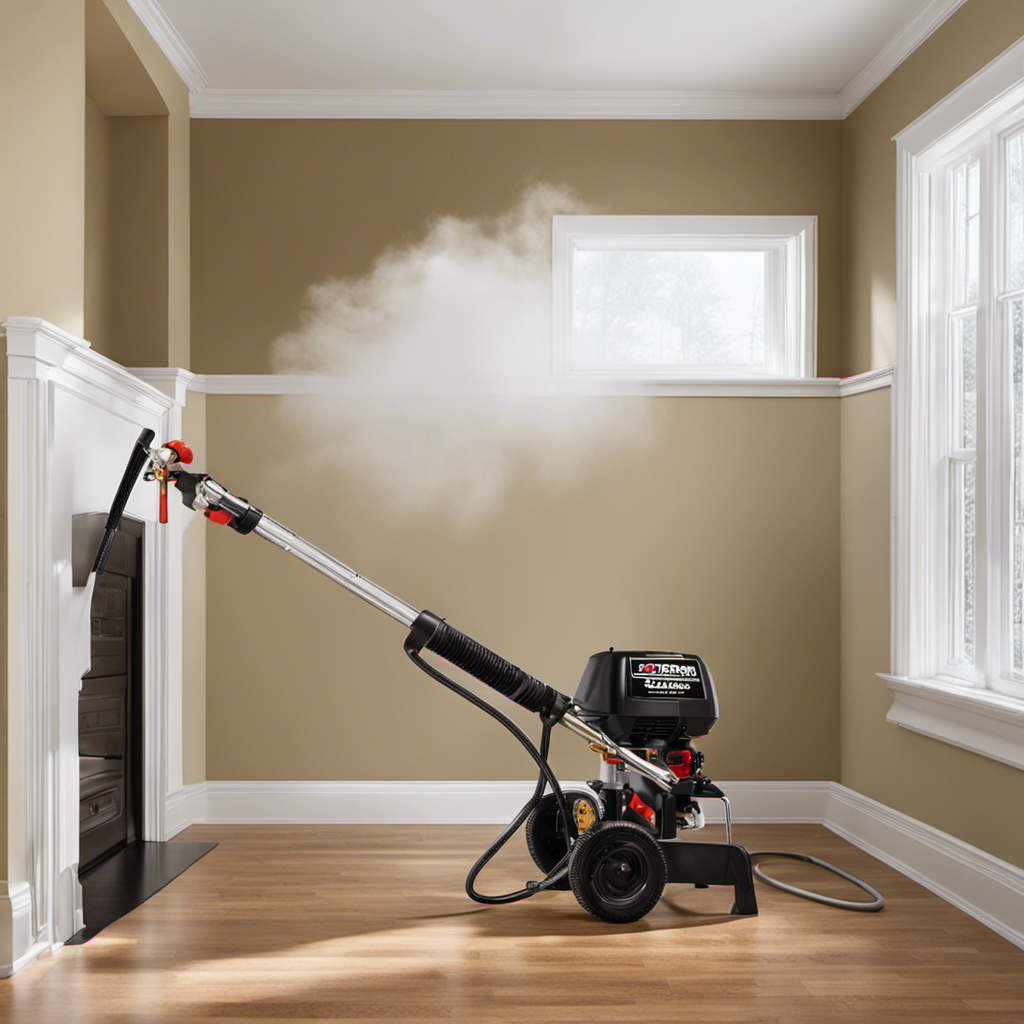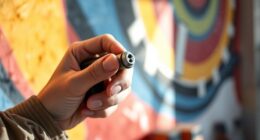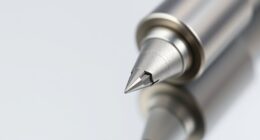For **Do-It-Yourself enthusiasts** and professionals, here’s a helpful tip: Maintaining your airless paint sprayer is easy when you regularly change the filters. This straightforward action will improve its performance and lifespan significantly!
As a professional painter, I understand the importance of keeping the filters in optimal condition. In this article, we will explore the signs that indicate it’s time to replace the filters, how often they should be replaced, and the different types of filters available.
Additionally, I will share tips for proper maintenance and common mistakes to avoid.
Let’s dive in and ensure your airless paint sprayer stays in top shape!
Key Takeaways
- Regularly replacing filters improves performance and lifespan of airless paint sprayer.
- Signs that your filters need to be replaced include uneven spray patterns, clogging in the spray tip, decreased paint flow, and excessive pressure build-up.
- Filters should be replaced regularly for optimal performance, and the manufacturer’s recommended replacement schedule should be followed.
- Understanding the different types of filters and choosing the right one for your needs is important for optimal performance and longevity.
Importance of Regular Filter Replacement
You should regularly replace the filters in your airless paint sprayer because it ensures optimal performance and prevents clogs.
Filter maintenance techniques are crucial for the smooth operation of your paint sprayer. Clean filters play a vital role in maintaining the quality of your paint finish and preventing potential issues.
When the filters are clogged with dirt, debris, or dried paint particles, it can lead to uneven spray patterns, reduced pressure, and even damage to the paint sprayer.
By regularly replacing the filters, you can ensure that your airless paint sprayer operates at its full potential, providing consistent and high-quality results.
Now, let’s explore the signs that your filters need to be replaced, so you can avoid any potential problems down the line.
Signs That Your Filters Need to Be Replaced
If the spray from your machine becomes uneven or clogged, it’s a sign that it’s time to swap out those filters. Regular maintenance of airless paint sprayer filters is crucial for optimal performance and longevity of your equipment. Proper filter care offers several benefits, including improved spray quality, reduced downtime, and extended lifespan of the sprayer. Neglecting filter replacement can lead to costly repairs and diminished productivity.
To determine when filters need to be replaced, it’s important to be aware of the signs indicating their deterioration. Here are some common indicators that your filters are due for a change:
| Signs of Filter Replacement |
|---|
| Uneven spray pattern |
| Clogging in the spray tip |
| Decreased paint flow |
| Excessive pressure build-up |
| Reduced performance |
If you notice any of these signs, it’s time to replace your filters to ensure optimal performance. But how often should filters be replaced? Let’s explore this in the next section.
How Often Should Filters Be Replaced
In this discussion, I will address the key points of filter replacement frequency and signs of filter deterioration.
As the user of an airless paint sprayer, it’s important to understand how often filters should be replaced to ensure optimal performance.
Additionally, being able to identify signs of filter deterioration will help you maintain the efficiency and effectiveness of your paint sprayer.
Filter Replacement Frequency
The filter should be replaced regularly to ensure optimal performance of the airless paint sprayer. Maintaining a proper filter replacement schedule is crucial for the longevity and efficiency of the equipment. Here are some best practices for filter maintenance:
-
Regular Inspection:
-
Check the condition of the filter before every use.
-
Look for any signs of clogging or damage.
-
Timely Replacement:
-
Replace the filter based on the manufacturer’s recommended schedule.
-
Consider replacing it more frequently if you work with thick or heavily pigmented paints.
By adhering to a regular filter replacement schedule and following these best practices, you can ensure that your airless paint sprayer operates at its best. Neglecting filter maintenance can result in poor performance and potential damage to the sprayer.
Now, let’s explore the signs of filter deterioration and how to address them.
Signs of Filter Deterioration
Regularly inspecting the filter and looking for signs of clogging or damage helps ensure optimal performance of your equipment. Proper filter maintenance is crucial to extend its lifespan and maintain the efficiency of your airless paint sprayer. One of the first signs of filter deterioration is a decrease in paint flow or pressure. If you notice that the spray pattern is uneven or the paint is not being evenly distributed, it may be a sign that the filter is clogged or damaged.
Additionally, inspect the filter for any visible signs of wear or tear, such as cracks or holes. If you see any of these signs, it is important to replace the filter as soon as possible to avoid further damage to your equipment.
Understanding the different types of filters is the next step in maintaining your airless paint sprayer.
Understanding the Different Types of Filters
You’ll need to familiarize yourself with the different types of filters used in airless paint sprayers. Choosing the right filter for your paint sprayer is crucial in ensuring optimal performance and longevity. There are various types of filter materials available, each with its own unique characteristics and benefits.
Here are two sub-lists to help you understand the different types of filters:
-
Mesh Filters
-
Made from woven wire mesh
-
Ideal for removing larger particles and debris from the paint
-
Paper Filters
-
Made from cellulose or synthetic fibers
-
Offers superior filtration, capturing even the smallest particles
Now that you know the types of filter materials, you can make an informed decision when selecting the right filter for your paint sprayer. It’s important to consider factors such as the type of paint you’ll be using and the desired finish. By choosing the appropriate filter, you can achieve optimal spray pattern and minimize clogs.
Understanding the different types of filters is the first step in ensuring efficient painting results. Next, let’s explore the factors that affect filter lifespan.
Factors That Affect Filter Lifespan
When it comes to the lifespan of filters in an airless paint sprayer, two key factors play a crucial role: usage frequency and duration, as well as the type of paint used.
The more often and longer the sprayer is used, the quicker the filters may become clogged or worn out.
Additionally, different types of paint can have varying levels of viscosity and particulate matter, which can impact the lifespan of the filters.
Usage Frequency and Duration
To ensure optimal performance, it’s important to keep track of how often and for how long you use your airless paint sprayer. Here are some usage tips to help you get the most out of your equipment and avoid common mistakes:
- Use the sprayer on a regular basis to prevent the paint from drying and clogging the system.
- Be mindful of the duration of each painting session. Prolonged use can strain the motor and lead to overheating.
By following these usage tips, you can maximize the lifespan of your airless paint sprayer and minimize the need for repairs or replacements.
Now, let’s move on to the next section, where we will discuss the impact of the type of paint used on the performance of your sprayer.
Type of Paint Used
Using the wrong type of paint can negatively affect the performance and functionality of your airless paint sprayer. It is crucial to understand the impact of paint viscosity on the sprayer’s operation.
Different paint finishes have varying viscosity levels, which can determine the compatibility with your airless paint sprayer. High-viscosity paints, such as textured or elastomeric coatings, require a sprayer with a larger pump size and higher pressure capabilities. On the other hand, low-viscosity paints, like stains or lacquers, work well with smaller pumps and lower pressure settings.
Using the wrong viscosity can lead to clogs, uneven spray patterns, and reduced efficiency. Therefore, it is essential to choose the appropriate paint viscosity for your airless paint sprayer to ensure optimal performance.
Transitioning into the next section about ‘diy filter replacement vs. professional maintenance,’ it is crucial to maintain the sprayer’s filters to prevent paint debris from clogging the system.
DIY Filter Replacement Vs. Professional Maintenance
You should consider whether to replace the filters in your airless paint sprayer yourself or hire a professional for maintenance. Here are some points to help you make an informed decision:
-
DIY Filter Replacement:
-
Cost effective: Doing it yourself can save you money on labor costs.
-
Convenience: You can replace the filters at your own pace without relying on someone else’s schedule.
-
Professional Maintenance:
-
Expertise: Professionals have the knowledge and experience to properly replace filters and ensure optimal performance.
-
Warranty protection: Hiring a professional may be necessary to maintain your warranty coverage.
Considering the DIY vs professional approach for filter replacement is crucial for cost-effective maintenance. However, keep in mind that proper maintenance extends beyond filter replacement. It involves regular cleaning and inspection to ensure the filters are functioning efficiently.
Tips for Properly Maintaining Filters
When it comes to maintaining filters for airless paint sprayers, it’s important to understand the frequency at which they should be replaced. Regularly replacing filters ensures optimal performance and prevents clogs or damage to the sprayer.
However, before replacing a filter, it’s worth considering whether cleaning it might be a viable option, as this can help extend its lifespan and save on replacement costs.
Filter Replacement Frequency
The filter’s replacement frequency depends on how frequently you use the airless paint sprayer. If you use it frequently, you may need to replace the filter more often to maintain optimal performance. Regular cleaning is important to ensure that the filter is free from clogs and debris, but there are also benefits to using high-quality filters.
Here are two key points to consider:
-
Regular cleaning: Cleaning the filter regularly helps to remove accumulated paint particles and other contaminants, preventing them from clogging the spray tip. This ensures a smooth and consistent paint application, reducing the risk of uneven coverage or clogged spray patterns.
-
Benefits of high-quality filters: Investing in high-quality filters can significantly improve the performance and efficiency of your airless paint sprayer. These filters are designed to capture even the smallest particles, ensuring a clean and uninterrupted flow of paint. They also tend to have a longer lifespan, reducing the frequency of filter replacements and saving you time and money.
Considering these factors, it is important to find the right balance between cleaning and replacing filters to maintain optimal performance and avoid unnecessary expenses.
Cleaning Vs. Replacing
Now that we have discussed the frequency of filter replacement, let’s delve into the topic of cleaning versus replacing the filters in your airless paint sprayer.
While it is important to replace filters when they become excessively dirty or damaged, there are instances where you can extend their lifespan through proper maintenance. DIY cleaning is a cost-effective option that can help remove debris and prolong the filter’s effectiveness.
Regular filter maintenance involves removing the filter, gently rinsing it with water or a mild detergent, and allowing it to dry completely before reinserting it into the sprayer. However, it is crucial to note that cleaning can only go so far, and eventually, you will need to replace the filter to ensure optimal performance.
Transitioning into the subsequent section, let’s explore some effective ways to extend the lifespan of your filters.
Extending the Lifespan of Your Filters
To extend the lifespan of your filters, you should regularly clean and maintain them. Here are some tips for filter maintenance that can help you save money and ensure optimal performance:
- Clean the filters regularly by removing any debris or dust particles that may have accumulated on the surface.
- Use compressed air or a soft brush to gently clean the filters without damaging them.
- Replace the filters when they become clogged or damaged beyond repair.
- Consider using cost-effective filter replacement options, such as reusable filters or aftermarket filters that are compatible with your airless paint sprayer.
By following these maintenance tips, you can maximize the lifespan of your filters and avoid unnecessary expenses.
Now let’s move on to the next section and discuss some common mistakes to avoid when replacing filters.
Common Mistakes to Avoid When Replacing Filters
When replacing filters, it’s important to avoid common mistakes that can lead to inefficiency and potential damage. Proper filter maintenance is crucial for the optimal performance of airless paint sprayers. Here are some DIY filter replacement tips to ensure you get the most out of your equipment:
| Common Mistakes | Tips to Avoid Them |
|---|---|
| Not replacing filters regularly | Replace filters according to the manufacturer’s recommendations. Neglecting to do so can result in reduced efficiency and clogging. |
| Incorrect installation | Follow the instructions provided by the manufacturer to ensure proper installation. Improperly installed filters can lead to leaks and decreased performance. |
| Using the wrong type of filter | Always use filters specifically designed for your airless paint sprayer. Using the wrong filter can lead to poor filtration and potential damage to the equipment. |
| Not cleaning the filters before replacement | Clean the filters thoroughly before installing new ones. This helps maximize their lifespan and ensures efficient performance. |
Benefits of Timely Filter Replacement
By timely replacing your filters, you can experience the benefits of improved efficiency and extended equipment lifespan. Regular maintenance is crucial for optimal performance of your airless paint sprayer. Here are the benefits you can expect:
-
Improved Efficiency:
-
Clean filters allow for better airflow, ensuring consistent paint flow and reducing clogs.
-
Increased efficiency means less time wasted on troubleshooting and cleaning, resulting in more productive painting sessions.
-
Extended Equipment Lifespan:
-
Clogged filters strain the motor and other internal components, leading to premature wear and tear.
-
By replacing filters regularly, you can prevent costly repairs and prolong the life of your airless paint sprayer.
To ensure maximum effectiveness, proper filter storage is essential:
- Store filters in a clean, dry place to prevent dust and moisture buildup.
- Avoid exposing filters to extreme temperatures or direct sunlight, as this can degrade their performance.
Frequently Asked Questions
Can I Clean and Reuse Airless Paint Sprayer Filters Instead of Replacing Them?
Yes, you can clean and reuse airless paint sprayer filters instead of replacing them, but there are pros and cons. Cleaning can save money, but reused filters may not perform as well as new ones and could lead to clogs or uneven spray patterns.
How Can I Tell if My Filters Are Clogged and Need to Be Replaced?
Regular filter maintenance is crucial to ensure optimal performance. Signs of clogged filters include reduced paint flow, uneven spray pattern, and increased pressure. If these symptoms persist after cleaning, it may be time to replace the filters.
Are There Any Specific Types of Filters That Are More Durable and Have a Longer Lifespan?
Most durable filters for airless paint sprayers are made of high-quality materials like stainless steel or nylon. These filters have a longer lifespan and can withstand the demands of paint spraying applications.
Can I Use Non-Branded or Generic Filters for My Airless Paint Sprayer?
I can use non-branded filters for my airless paint sprayer, but there are pros and cons. It’s important to choose the right filter based on the specific needs of the paint sprayer to ensure optimal performance and longevity.
Should I Hire a Professional to Replace My Filters or Can I Do It Myself?
I can save money by replacing the filters in my airless paint sprayer myself instead of hiring professionals. It’s a simple task that requires minimal effort and can be done regularly for optimal performance.
Conclusion
In conclusion, regular filter replacement is crucial for maintaining the efficiency and longevity of your airless paint sprayer. By recognizing the signs of worn-out filters and understanding the different types available, you can ensure optimal performance.
Proper maintenance and avoiding common mistakes will help extend the lifespan of your filters, saving you time and money in the long run.
So, why wait for clogged filters to hinder your painting project? Take action now and enjoy smooth and flawless results.
Drenched in creativity and armed with a fountain pen, Isolde weaves words as gracefully as a painter strokes their canvas. A writer for Paint Sprayer Zone, her passion for colors, textures, and spaces finds a harmonious blend with her profound knowledge of painting tools and techniques.
Having grown up in a family of artists, Isolde’s tryst with paints began early. While her relatives expressed themselves on canvas, Isolde found her medium in words. She dedicated herself to chronicling the world of painting, understanding the nuances of each tool, and the artistry behind every spritz of a paint sprayer.



